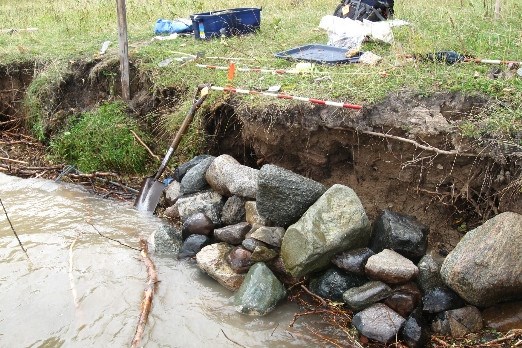Anglers discovered 4,600-year-old human remains near Big Trout Lake last fall that a Lakehead University archaeological team has discovered was a man that lived at the same time the Great Pyramids were being built in ancient Egypt.
The fisherman, residents of Kitchenuhmaykoosik Inninuwug First Nation, made the discovery at the mouth of the Bug River as water levels have dropped. LU archaeology professor Scott Hamilton said it appears they found an ancient burial site.
The skeleton discovered is of a man of Aboriginal descent who was in his 30s or 40s. He was about five-and-a-half feet tall and had a robust, muscular build. Hamilton said the man likely held high status because of a seemingly formal burial.
Isotope testing revealed the man had a fish-based diet, with a side of hunted land mammals like caribou.
Hamilton said the man was probably associated with what archaeologists call the shield archaic culture. – early hunters and gatherers who occupied an extensive chunk of the Canadian Shield from northern Saskatchewan to northern Quebec. They lived in small family groups and survived from fishing, hunting and trapping – a lifestyle fairly common to Aboriginal people in this region for the last 7,000 years.
"It’s a very important fragment in a story we know virtually nothing about in terms of human culture in far Northern Ontario," Hamilton said.
There have been two other discoveries in the same region. One was a 7,000-year-old skeleton found 20 years ago and 4,200-year-old remains found near Big Trout Lake five years ago.
"There’s been very little work done in this territory and every piece of information is new information quite literally," Hamilton said. "Human remains are very rarely found in archaeological contexts anywhere in the sub-Arctic, so to find several that are about he same age in the same area is a very important source of information about lifestyle, health profile, diets and just the physical nature of their health at this very early time."
While Hamilton said he expects the remains found near KI are distant ancestors of some Aboriginal people who are currently residing in Northern Ontario, but sorting out ancestor relationships over enormous distances of time are not really possible.
The LU research time has been working in collaboration with the KI community and its chief, Donny Morris says the man will be reburied after all tests are completed in the traditions of his forebears.
Sign in or register
- Messages
- Post a Listing
- Your Listings
- Your Profile
- Your Subscriptions
- Your Likes
- Your Business
- Support Local News
- Payment History
Registered Users
Already have an account?
New Users
Create a free account.
